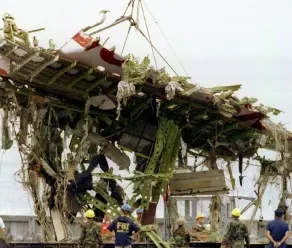
Missile may have caused TWA crash
Jun 19, 2013

The tragic crash of TWA Flight 800 in 1996 has long been the subject of speculation and investigation, with some evidence suggesting that a missile may have been involved. Eyewitness accounts and radar data indicated a possible explosion in the vicinity of the aircraft shortly after takeoff from New York. Despite an extensive investigation by the National Transportation Safety Board, which ultimately attributed the crash to a fuel tank explosion, theories regarding a missile strike persisted among various observers and conspiracy theorists. The incident remains a significant point of discussion regarding aviation safety and security measures.
Understanding the TWA Flight 800 Tragedy
The tragic crash of TWA Flight 800 on July 17, 1996, remains one of the most controversial aviation disasters in history. As the investigation unfolded, numerous theories emerged regarding the cause of the explosion that led to the loss of all 230 passengers and crew on board. One prevailing theory suggested that a missile may have been responsible for the disaster. This theory has generated significant debate, as well as a wealth of speculation among aviation experts and the public alike.
The Official Investigation
The National Transportation Safety Board (NTSB) conducted an extensive investigation into the crash. Initial findings pointed to a fuel tank explosion as the primary cause. However, the presence of eyewitnesses who reported seeing a streak of light followed by the explosion led many to believe that a missile could have played a role. The NTSB ultimately concluded that the fuel tank explosion was due to a combination of factors, including a spark from faulty wiring.
Eyewitness Accounts
Eyewitness testimonies have been a crucial part of the narrative surrounding the TWA Flight 800 crash. Many individuals, including those on land and in nearby boats, claimed they saw a bright light ascend into the sky just before the explosion. Some witnesses even asserted it looked like a missile. This collection of accounts has fueled speculation and conspiracy theories, leading to further investigations and discussions surrounding the incident.
Missile Theory: A Closer Look
The "missile theory" gained traction due to several factors. First, the proximity of the crash site to military operations conducted off the coast of Long Island raised questions about whether a missile misfire could have inadvertently struck the aircraft. Second, the timing of the explosion coincided with the launch of a military exercise in the area, leading many to connect the dots.
Government Response and Public Reaction
Following the crash, the "government's response" was swift. The FBI was brought in to investigate the possibility of a missile strike, but after months of investigation, they concluded there was no evidence supporting this theory. Nonetheless, the public's reaction was mixed. Many families of victims continued to believe in the missile theory, feeling that the official narrative was insufficient and lacked transparency.
Chart: Eyewitness Accounts and Missile Theory
| Source | Account Type | Details |
|---|---|---|
| Land Witness | Visual | Saw a bright light shoot upwards before the explosion. |
| Boating Witness | Visual | Reported seeing a streak of light, described it as resembling a missile. |
| Military Personnel | Oral | Heard about military exercises taking place nearby. |
| Investigator Reports | Documentation | No evidence found to support missile theory. |
Media Coverage and Theories
The media played a significant role in shaping public perception of the TWA Flight 800 crash. Various outlets explored the "missile theory", providing a platform for experts and conspiracy theorists to express their views. This coverage often highlighted the emotional stories of victims’ families, drawing attention to the deep sense of loss and the desire for answers.
Legacy of TWA Flight 800
The legacy of TWA Flight 800 continues to impact aviation safety and regulations. The incident prompted changes in how aircraft fuel systems are designed, particularly concerning the prevention of fuel tank explosions. The crash also reinforced the importance of clear and transparent communication from government agencies during such tragic events, highlighting the need for trust between the public and authorities.
Conclusion: Continuing Debate
In conclusion, while the official investigation attributed the crash of TWA Flight 800 to a fuel tank explosion, the "missile theory" persists as a topic of debate. The combination of eyewitness accounts, military operations, and the emotional weight of the tragedy ensures that discussions surrounding the incident will continue. As we reflect on this tragedy, it serves as a reminder of the complexities involved in aviation safety and the enduring quest for truth in the wake of disaster.
Related Articles

Explore Thailand: The Best Islands to Visit for Paradise, Adventure, and Relaxation

The Ultimate Guide to the Best Islands in Thailand for Your Next Getaway

Do babies need passports? How to get a passport for a newborn

How to get a U.S. passport fast: here’s how to expedite the process

What is Mobile Passport Control: 5 reasons why you should use it

SENTRI vs. Global Entry: A detailed guide

Do you need a passport to go to the Bahamas? Let’s find out

Do you need a passport to go to Mexico? A detailed guide

Do you need a passport to go to Canada? We got the answer

Do You Need a Passport for a Cruise: An Essential Travel Guide

Booster Seat Requirements: All the Rules to Follow in Your Rental Car

What Are the World’s Most Powerful Passports, and How Does Yours Rank?

How to Take a Passport Photo at Home: A Helpful Guide

You've got to have heart! Southwest's new livery

Your opinion: Should water be free on low cost carriers?

Young women bolder than guys as solo travellers
